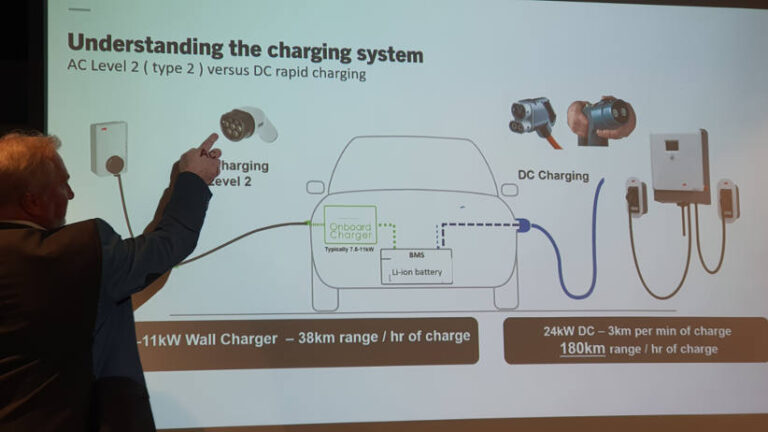One of the major reasons fleet management will be leading the way in adopting electric vehicles is a greater awareness of the specific activities and performance requirements that are needed from their vehicles.
This was one of the main factors that came out of a technical meeting organised by The Australian Institute of Traffic Planning and Management (AITPM) at the end of April 2022.
The meeting was addressed by Dr Tim Brooker, National Technical Leader, Traffic and Transport, EMM and Steve Amor, Electric Vehicle Segment Lead Electrification, ABB Australia.
The presenters covered current trends in electric vehicle sales both here and overseas and future developments in charging infrastructure.
Current situation and trends
As is well known, Australia is behind most other major countries in adapting electric vehicles. Dr Brooker compared a range of countries and found Australia was 13th in terms of GDP but only 19th in terms of electric vehicle sales (full electrics, plug in hybrids and fuel cells).
By comparison Norway, which he said has some similarities with Australia in terms of low pollution density, was 29th in terms of GDP but 4th in terms of vehicle sales. All new cars in Norway will be electric by 2025.
In Australia, the proportion of new cars that were electric tripled in 2021 but starting from a very low base.
I would caution about the reporting of growth figures in 2022. Certainly there will be a continuation of this trend, but the Federal Chamber of Automotive Industries is only just now getting the figures from Tesla and new player Polestar in 2022 which will inflate the growth numbers from this source.
One of the most fascinating analyses from Dr Brooker was a graph showing the adoption rates in the USA for new technologies from electricity and the telephone in the early 1900s to the latest innovations.
Recent new technologies such as Digital cameras, MP3 players, HDTV, Social Media, Smartphone, and Tablet have shown astronomical quick adoption rates. This suggests we are at a time where embracing new technologies is more of the norm. This is supported by the rapid increase brands and models of electric vehicles now appearing on the market.
Steve Amor gave a comprehensive summation of the current and future developments in vehicle charging infrastructure and the range of industries that are taking up the electrification of their fleets.
But it is not just taking up the biggest and most powerful option. He emphasised the that you may not need to have the fastest chargers. A managed approach will depend on the cost and availability of power sources, your fleet characteristics, and power requirements
He also emphasised that we have to move away from a approach of seeking charging only when the battery level is very low. He said we need the attitude we have developed with our mobile phones – you look to top it up at every convenient opportunity. This is even more critical with private owners or situations where the use of the vehicle is more random.
Knowing your specific needs
In question time, the presenters were asked about how well do we understand the vehicle performance needs.
Good fleet management means measuring what is actually happening, specifically for your operations.
A surprising number of delivery companies know that their typical vehicles travel less than a full battery distance each day.
In my own research I spoke to a building construction company, Worthington Constructions, and they are closely looking at electric utes especially with bi-directional charging and the opportunity to have their vehicle as a power source for on-site activities.
Yet our attitudes to the new technologies can be strongly affected by commonly expressed generalities and even myths about performance aspects especially with electric vehicles.
What masquerades as analysis in media reporting and government policy setting, is often one-off, anecdotes about hypothetical situations.
“Will I be able to drive the vehicle from Sydney to Melbourne?” is too often asked of a vehicle that will never be required to make such a trip and even it had to make the trip, some planning and setting of a reasonable expectation would still make it possible, and certainly easier as things develop in the future.
“What is its range?” is important but it is best asked AFTER you have answered the question “How will the vehicle be used?”
Fleet management should be a good demonstration of assessing real needs can make a new technology more tempting. The average car in Australia, for example, does about 270 kms a week. Obviously then, there are many cars that do less. Embracing sustainable transport in many circumstances could be done without arduous consequences.
With fleets leading the way, more people will be encouraged to adapt the appropriate technology and electric vehicles will benefit from the economy of scale.






